Birth: Indianapolis, Indiana, November 5, 1867
Death: Giza, Egypt, June 6, 1942
One of the most prominent founding fathers of modern scientific archaeology, Egyptologist George Andrew Reisner was born in Indianapolis in 1867 to a German-American family originally from Worms. Reisner eventually made his way east to Harvard University for his B.A. (1889), M.A. (1891), and Ph.D. (1893) degrees. In 1893, one year after his marriage to Mary Bronson, he became a Travelling Fellow of Harvard and left for Berlin to study first Semitics and then ancient Egyptian under Adolf Erman and Kurt Sethe. Reisner returned to Harvard in 1896, where he obtained a post as Instructor in Semitics.
|
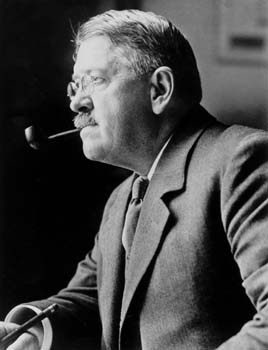
George Reisner, from The Rotarian
49, no. 1 (July 1936), p. 23
(Photo by Bob Davis of the
New York Sun); June 26, 1933
(B8331) |
| In 1897 he spent a year in Cairo working on the Catalogue Général Project for the Egyptian Museum, then received five years' funding for excavation from California-based Mrs. Phoebe Apperson Hearst, mother of the well-known newspaper publisher W. R. Hearst. Reisner concentrated on the great cemeteries of Naga ed-Deir, as well as the sites of Quft and Deir el-Ballas. He applied the methodical approach he had learned in Berlin to his excavation techniques, and began to develop a unique working system. He emphasized field photography as a fundamental element of the archaeological process, and established a wide range of expedition record books and numbering systems. |
Reisner attained his most important site concession in 1902: the Old Kingdom cemeteries surrounding the three great pyramids of Giza. From 1905 on, his expedition was supported by Harvard University and the Museum of Fine Arts, Boston. By 1910 he was or had been Archaeological Director of the Nubian Archaeological Survey by the Egyptian Government (1907–9), Director of the Harvard Excavations at Samaria, Palestine (1909–10), assistant Professor of Semitic Archaeology (1905–10), Director of the Harvard–Boston Egyptian Expedition, Professor of Egyptology at Harvard University, and Curator of the Egyptian Department of the Museum of Fine Arts, Boston. |
|
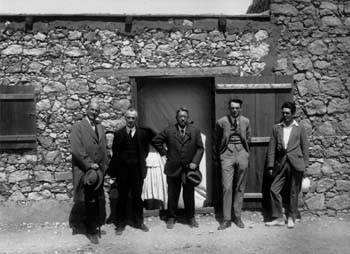
Arthur Merton (London Times), Alfred Lucas, George Reisner, Dows Dunham, and Noel F. Wheeler, outside the magazine for G 7000 X, Hetepheres I; April 11, 1927 (B6205)
|

George Reisner with ceramic vessel; March 29, 1929 (A6721) |
|
Reisner died at Giza in Harvard Camp in 1942. In his final years, despite near total blindness, he continued working, dictating manuscripts to a secretary. By the end of his career, he had explored arguably the most famous archaeological site in the world (the Giza Pyramids), discovered thousands of artifacts and hundreds of artistic masterpieces, rewritten the history of Nubia and three millennia of Egypto–Nubian relations, and permanently altered the course of modern archaeology. He is buried in the American cemetery in Mari Girgis, Cairo.
|
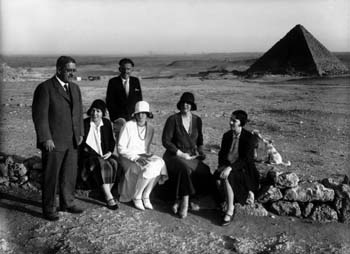
Visit of Queen Marie of Romania, Harvard Camp, looking southeast towards the Menkaure Pyramid; from left to right: George Reisner, Mrs. Mary Reisner, Hansmartin Handrick (standing behind), Queen Marie’s youngest daughter Princess Ileana (white dress), Queen Marie (dark dress), and Miss Mary Reisner; March 17, 1930 (A5423)
|
|
Selected Literature on George A. Reisner
A. Scharff, Archiv für Orientforschung 15 (1945-51, pp. 187-88;
D. Dunham, American Journal of Archaeology 46 (1942), pp. 410-12;
H.E. Winlock, American Philosophical Society Year Book (1942), pp. 369-74;
G. Brunton, Annales du Service des Antiquités de l'Egypte 41 (1942), pp. 11-18;
J.L. Myers, Man 42 (1942), no. 76, p. 137;
A.H. Gardiner, Nature 150 (1942), p. 84;
D. Dunham, Recollections of an Egyptologist (Boston, 1972), passim;
W.R. Dawson and E. Uphill, Who was Who in Egyptology, 2nd ed., London, 1972, pp. 244-45; 3rd edition revised by M.L. Bierbrier (London, 1995), pp. 351-52.
|
P. Der Manuelian, "Excavating the Memphite Cemeteries: The Giza Necropolis." In L’Art égyptien au temps des pyramides and Egyptian Art in the Age of the Pyramids (exhibition catalogues chapter). Paris: Musée du Louvre, pp. 124-33, and New York: Metropolitan Museum of Art, 1999, 139-53.
idem, "George Andrew Reisner on Archaeological Photography," Journal of the American Research Center in Egypt, 29 (1992), pp. 1-34.
idem, "A month in the life of a great Egyptologist: George Reisner in March, 1912," KMT 7, No. 2 (Summer 1996), pp. 60-75.
idem, "A Race against Time in the Shadow of the Pyramids. The Museum of Fine Arts, Boston and the Giza Necropolis, 1902-1990," KMT 1, no. 4 (1990-91), pp. 10-21.
idem, "George A. Reisner: Shooting the Pyramids," View Camera Jan.-Feb., 1995, pp. 8-13.
|
|
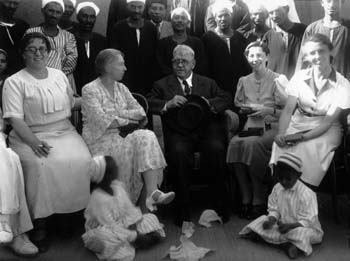
George Reisner's seventieth birthday, Harvard Camp, Giza; left to right: Evelyn Perkins, Mrs. Mary Reisner, George Reisner, Miss Mary Reisner, Dorothy Ginger, with workmen behind and boys in front; November 5, 1937 (A7873)
|
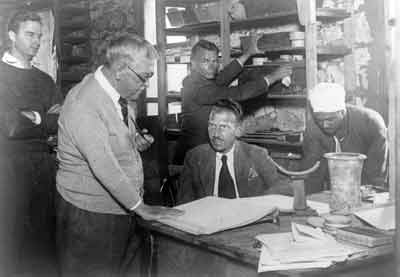
Harvard Camp, Giza offices; from left to right: Frank O. Allen, George Reisner, Nicholas Melnikoff, Hansmartin Handrick (seated), and Mohammed Said Ahmed (rephotograph from Al-Mussawar Arabic magazine, no. 740, December 16, 1938); January 4, 1939 (B9021) |
|
|